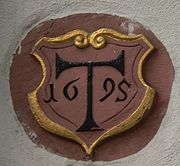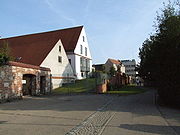
Hospital Brothers of St. Anthony
Encyclopedia

History

Dauphiné
The Dauphiné or Dauphiné Viennois is a former province in southeastern France, whose area roughly corresponded to that of the present departments of :Isère, :Drôme, and :Hautes-Alpes....
, and his son, and confirmed by Pope Urban II
Pope Urban II
Pope Urban II , born Otho de Lagery , was Pope from 12 March 1088 until his death on July 29 1099...
in the same year, in thanksgiving for the son's miraculous cure from St. Anthony's fire thanks to the relics of Saint Anthony the Great.
The relics were housed in the church of Saint Anthony at La-Motte-Saint-Didier (the present Saint-Antoine-l'Abbaye
Saint-Antoine-l'Abbaye
Saint-Antoine-l'Abbaye, also Saint-Antoine-en-Viennois, is a commune in the Isère department in south-eastern France.Formerly known as La-Motte-Saint-Didier, it was renamed after becoming the home of the relics of Saint Anthony the Great in the 11th century, and shortly afterwards of the original...
, Isère
Isère
Isère is a department in the Rhône-Alpes region in the east of France named after the river Isère.- History :Isère is one of the original 83 departments created during the French Revolution on March 4, 1790. It was created from part of the former province of Dauphiné...
), to which was attached a Benedictine priory, whose members tended the shrine. Gaston and his community, which at this date was composed of laymen, set up a hospital nearby, where they cared for pilgrims to the shrine and for the sick, particularly those afflicted with St. Anthony's fire, a disease very common in the Middle Ages, particularly among the poor. Relations with the resident Benedictines were not good, however, and conflicts were frequent.
The members of the community wore a black habit with the Greek letter Tau
Tau
Tau is the 19th letter of the Greek alphabet. In the system of Greek numerals it has a value of 300.The name in English is pronounced , but in modern Greek it is...
(also known as St. Anthony's cross) in blue. At first laymen, they received sanction as a monastic order from Pope Honorius III
Pope Honorius III
Pope Honorius III , previously known as Cencio Savelli, was Pope from 1216 to 1227.-Early work:He was born in Rome as son of Aimerico...
in 1218. In 1248 they adopted the Rule of St. Augustine
Rule of St. Augustine
The Rule of St. Augustine is a religious rule employed by a large number of orders, including the Dominicans, Servites, Mercederians, and Augustinians.-Overview:...
and were constituted canons regular by Pope Boniface VIII
Pope Boniface VIII
Pope Boniface VIII , born Benedetto Gaetani, was Pope of the Catholic Church from 1294 to 1303. Today, Boniface VIII is probably best remembered for his feuds with Dante, who placed him in the Eighth circle of Hell in his Divina Commedia, among the Simonists.- Biography :Gaetani was born in 1235 in...
in 1297. At this time the conflict that had grown up between the Antonines and the Benedictine monks responsible for the relics had become severe: the Pope put an end to it by dismissing the Benedictines to Montmajour Abbey
Montmajour Abbey
Montmajour Abbey is a fortified Benedictine monastery built between the 10th and 13th century on what was then an island five kilometers north of Arles, in the Bouches-du-Rhône département, Provence, in the south of France.The Abbey is noted for its 11th-14th century graves, carved in the rock,...
and giving custody of the shrine to the Antonines.
Due to the community's successes further hospitals were opened in Gap
Gap, Hautes-Alpes
Gap is a commune in southeastern France, the capital of the Hautes-Alpes department.-Geography:An Alpine crossroads at the intersection of D994 and Route nationale 85 the Route Napoléon, Gap lies above sea level along the right bank of the Luye River...
, Chambéry
Chambéry
Chambéry is a city in the department of Savoie, located in the Rhône-Alpes region in southeastern France.It is the capital of the department and has been the historical capital of the Savoy region since the 13th century, when Amadeus V of Savoy made the city his seat of power.-Geography:Chambéry...
and Besançon
Besançon
Besançon , is the capital and principal city of the Franche-Comté region in eastern France. It had a population of about 237,000 inhabitants in the metropolitan area in 2008...
, and later in Spain, Italy, Flanders
Flanders
Flanders is the community of the Flemings but also one of the institutions in Belgium, and a geographical region located in parts of present-day Belgium, France and the Netherlands. "Flanders" can also refer to the northern part of Belgium that contains Brussels, Bruges, Ghent and Antwerp...
and Germany, where one of their first monasteries and hospitals was opened in 1214 in Memmingen
Memmingen
Memmingen is a town in the Bavarian administrative region of Swabia in Germany. It is the central economic, educational and administrative centre in the Danube-Iller region. To the west the town is flanked by the Iller, the river that marks the Baden-Württemberg border...
. The congregation spread still more during the 14th century, during which they also cared for those suffering from the Black Death
Black Death
The Black Death was one of the most devastating pandemics in human history, peaking in Europe between 1348 and 1350. Of several competing theories, the dominant explanation for the Black Death is the plague theory, which attributes the outbreak to the bacterium Yersinia pestis. Thought to have...
, and at its height, in the 15th century, possessed about 370 hospitals. The congregation also produced a number of distinguished scholars and prelates. Among their privileges was that of caring for the sick of the papal household.

Protestant Reformation
The Protestant Reformation was a 16th-century split within Western Christianity initiated by Martin Luther, John Calvin and other early Protestants. The efforts of the self-described "reformers", who objected to the doctrines, rituals and ecclesiastical structure of the Roman Catholic Church, led...
, and more particularly once the connection was finally made between St. Anthony's Fire and the ergot
Ergot
Ergot or ergot fungi refers to a group of fungi of the genus Claviceps. The most prominent member of this group is Claviceps purpurea. This fungus grows on rye and related plants, and produces alkaloids that can cause ergotism in humans and other mammals who consume grains contaminated with its...
fungus, and the incidence of the affliction fell sharply. In 1616 a reform was ordained and partially carried out. In 1777 the congregation, hugely reduced, was canonically united with the Knights of Malta
Knights Hospitaller
The Sovereign Military Hospitaller Order of Saint John of Jerusalem of Rhodes and of Malta , also known as the Sovereign Military Order of Malta , Order of Malta or Knights of Malta, is a Roman Catholic lay religious order, traditionally of military, chivalrous, noble nature. It is the world's...
. Only a tiny number of houses remained open, and the remnants of the order were finally suppressed in the French Revolution
French Revolution
The French Revolution , sometimes distinguished as the 'Great French Revolution' , was a period of radical social and political upheaval in France and Europe. The absolute monarchy that had ruled France for centuries collapsed in three years...
and the years immediately following. The last few German houses were dissolved during the secularisation
German Mediatisation
The German Mediatisation was the series of mediatisations and secularisations that occurred in Germany between 1795 and 1814, during the latter part of the era of the French Revolution and then the Napoleonic Era....
of 1803.

